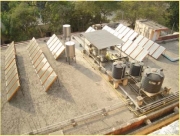/sub-categories/research-papers
Research Papers
Review of current practices in determining user charges & incorporation of economic principles of pricing of urban water supply
Posted on 19 Dec, 2010 07:21 PMThis paper is an outcome of The Energy Research Institute's (TERI’s) study for the Ministry of Urban Development (MoUD) under the Ministry’s Centre of Excellence (COE) to “Review the existing guidelines of determination of user charges for water and sanitation services and to incorporate economic principles of pricing in urban water supply sector in India”.
Transdisciplinary method for water pollution and human health research – A working paper by Peter Mollinga
Posted on 19 Dec, 2010 06:21 PMThis paper discusses how to go about designing an interdisciplinary or transdisciplinary research project or programme, with ZEF’s research initiative on ‘water pollution and human health’ in India as the background of the presentation. A summary is given of Pohl and Hirsch Hadorn’s main arguments regarding ‘design principles’ for inter- and transdisciplinary research, and the basic tools they have developed for this are discussed in the context of ZEF’s ‘water pollution and human health’ research initiative.
Formation of glacial lakes in the Hindu Kush-Himalayas and Glacial Lake Outburst Flood risk assessment - A report by ICIMOD
Posted on 19 Dec, 2010 05:17 PM This report by ICIMOD contains an assessment of the threat facing the Hindu Kush-Himalayan region from the recent (post-1950s) and rapid formation of meltwater lakes on the surface or at the end of a large number of the region’s glaciers owing to current climate warming. Individual case studies of the catastrophic outburst (glacial lake outburst floods or GLOFs) from such glacial lakes are introduced.
This report by ICIMOD contains an assessment of the threat facing the Hindu Kush-Himalayan region from the recent (post-1950s) and rapid formation of meltwater lakes on the surface or at the end of a large number of the region’s glaciers owing to current climate warming. Individual case studies of the catastrophic outburst (glacial lake outburst floods or GLOFs) from such glacial lakes are introduced.
Mine the gap: Connecting water risks and disclosure in the mining sector – A report by the World Resources Institute
Posted on 17 Dec, 2010 10:43 PMThis paper by the World Resources Institute outlines potential water-related risks facing the mining industry and highlights important gaps in water-related disclosure. The purpose is to provide information, questions, and tools to help the financial community better evaluate water-related risks facing mining companies.
Water management across space and time in India – A working paper by the University of Bonn
Posted on 17 Dec, 2010 10:09 PMThis working paper by the University of Bonn attempts to give a spatial and temporal overview of water management in India. It traces how people and the successive regimes made choices across space and time from a wide range of water control and distribution technologies. The paper divides the water management in India into four periods –
- the traditional system of water management before colonial times;
- response from the colonial rulers to manage the complex socio-ecological system;
- large scale surface water development after independence; and
- finally, the small-scale community and market-led revolution.
The wealth of waste: The economics of wastewater use in agriculture - A report by FAO
Posted on 17 Dec, 2010 07:36 PM This report by the Food and Agriculture Organisation (FAO) deals with the economics of wastewater use in agriculture. It presents an economic framework for the assessment of the use of reclaimed water in agriculture, as part of a comprehensive planning process in water resource allocation strategies to provide for a more economically efficient and sustainable water utilization.
This report by the Food and Agriculture Organisation (FAO) deals with the economics of wastewater use in agriculture. It presents an economic framework for the assessment of the use of reclaimed water in agriculture, as part of a comprehensive planning process in water resource allocation strategies to provide for a more economically efficient and sustainable water utilization.
Water footprint assessments of dehydrated onion products of Jain Irrigation Systems Ltd – A report by IFC
Posted on 17 Dec, 2010 07:05 PMThis work on water footprint assessments represents a pioneering effort on documenting the water consumption in Jain Irrigation Systems Limited’s (JISL) production of dehydrated onions and of micro-irrigation systems. It also assesses the sustainability of this water consumption and formulate response strategies.
Development of an area based Energy Service Company (ESCO) model for solar water heating (SWH) in India
Posted on 17 Dec, 2010 08:05 AM This report for the Ministry of New and Renewable Energy (MNRE) deals with the development of an area based Energy Service Company (ESCO) model for solar water heating in India. Internationally, Solar Water Heating (SWH) has been identified as one of the most promising decentralized solar applications, having significant potential to reduce electricity consumption and consequent emissions reduction. Several schemes for promotion of solar water heaters have been in operation in the country.
This report for the Ministry of New and Renewable Energy (MNRE) deals with the development of an area based Energy Service Company (ESCO) model for solar water heating in India. Internationally, Solar Water Heating (SWH) has been identified as one of the most promising decentralized solar applications, having significant potential to reduce electricity consumption and consequent emissions reduction. Several schemes for promotion of solar water heaters have been in operation in the country.
National Rural Livelihoods Mission – Framework for implementation by Ministry of Rural Development
Posted on 16 Dec, 2010 07:46 PMThis document prepared by the Ministry of Rural Development (MoRD) presents the framework for implementation of National Rural Livelihoods Mission. The key challenge, in India is to ensure that the economic growth is inclusive and leads to significant reduction of rural poverty.
Drought 2009: Overview and management – A report by the Ministry of Agriculture
Posted on 16 Dec, 2010 09:39 AMThis document on the management of drought during 2009 published by the Department of Agriculture and Cooperation of the Ministry of Agriculture presents the deficiency and erratic behavior of rainfall, impact of drought, mitigation efforts initiated and their results. During the deficient and erratic rainfall of South-West monsoon 2009, fourteen States declared drought/ drought like situation/ scarcity in 338 districts of the country.